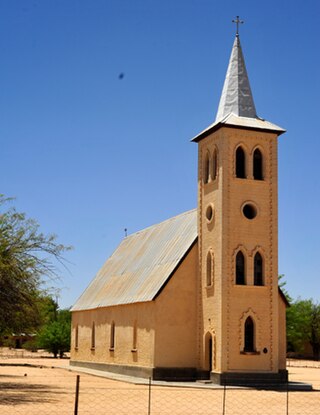
Swakopmund is a city on the coast of western Namibia, 352 km (219 mi) west of the Namibian capital Windhoek via the B2 main road. It is the capital of the Erongo administrative district. As of 2011, the town had 44,725 inhabitants and 196 km2 (76 sq mi) of land. In 2023, the population had increased to 75,921 people.

Karibib is a town in the Erongo Region of western Namibia. It has 3,800 inhabitants and owns 97 square kilometres (37 sq mi) of town land. Karibib is the district capital of the Karibib electoral constituency. It is situated on the Khan River, halfway between Windhoek and Swakopmund on the B2, the main road between Walvis Bay and Johannesburg. The town is known for its aragonite marble quarries and the Navachab Gold Mine.

Otjimbingwe is a settlement in the Erongo Region of central Namibia. Otjimbingwe has approximately 8,000 inhabitants and belongs to the Karibib electoral constituency.
The Trans-Kalahari Corridor is a paved highway corridor that provides a direct route from the port of Walvis Bay and Windhoek in central Namibia, through Botswana, to Pretoria in Gauteng province in South Africa. It initially cost approximately 850 million Namibian dollars and was officially opened in 1998.

TransNamib Holdings Limited, commonly referred to as TransNamib, is a state-owned railway company in Namibia. Organised as a holding company, it provides both rail and road freight services, as well as passenger rail services. Its headquarters are in the country’s capital Windhoek.

Vehicle registration plates of Namibia are yellow fluorescent metal plates with imprints in black. The standard version is uniform throughout the country, and carries one of the following forms:

Windhoek railway station is a railway station serving the city of Windhoek, the capital of Namibia. It is an important station in the Namibian rail network, and it is run by TransNamib.

Okahandja railway station is a railway station serving the town of Okahandja in Namibia. It is part of the TransNamib Railway.

Karibib railway station is a railway station serving the town of Karibib in Namibia. It is part of the TransNamib Railway.

Swakopmund railway station is a railway station serving the town of Swakopmund in Namibia. It is part of the TransNamib railway network. Its IATA code is ZSZ.

Walvis Bay railway station is a railway station serving the port city of Walvis Bay in Namibia. It is part of the TransNamib railway network.

The South West African Zwillinge 0-6-0T of 1898 was a narrow gauge steam locomotive from the German South West Africa era.

The rail service in Namibia is provided by TransNamib. The Namibian rail network consists of 2,687 km of tracks (2017).

The history of rail transport in Namibia began with a small mining rail line at Cape Cross in 1895. The first major railway project was started in 1897 when the German Colonial Authority built the 600 mm gauge Staatsbahn from Swakopmund to Windhoek. By 1902 the line was completed.

Usakos railway station is a railway station in Namibia serving the city of Usakos. It is part of the TransNamib railway network. The station building is dilapidated but passenger trains still stop at Usakos.
The Swakopmund–Windhoek line was a main 600 mm narrow-gauge railway line in Namibia. It was built in 1897 and operated until 1990 when the route name was changed.
After 28 years without a postal code system in Namibia, the national postal service provider NamPost introduced new postal codes in December 2018.

The Walvis Bay 2-4-2T Hope of 1899 was a South African steam locomotive from the pre-Union era in the Cape of Good Hope.
The COVID-19 pandemic in Namibia is part of the worldwide pandemic of coronavirus disease 2019 caused by severe acute respiratory syndrome coronavirus 2. The Minister of Health and Social Services, Kalumbi Shangula, announced on 14 March 2020 that the virus had reached Namibia. A Romanian couple constituted the two first cases and recovered 79 days after their initial diagnosis.















